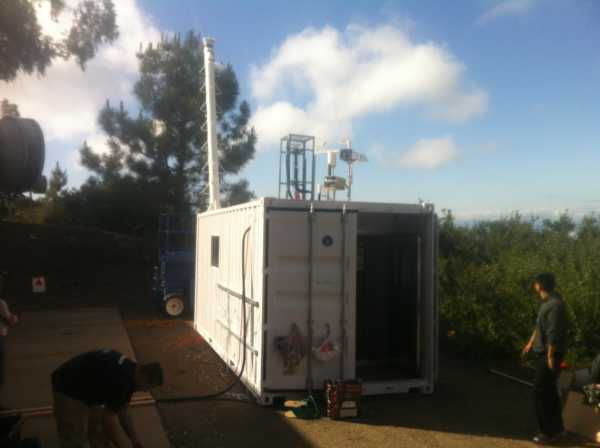Aerosol and Cloud Observations in La Jolla, CA, in May-June 2011 during SOLEDAD (Stratocumulus Observations of Los-Angeles Emissions Derived Aerosol-Droplets)
Aerosol and Cloud Observations in La Jolla, CA, in May-June 2011 during SOLEDAD (Stratocumulus Observations of Los-Angeles Emissions Derived Aerosol-Droplets)
About this collection
- Extent
-
1 digital object.
- Cite This Work
-
Modini, Robin L.; Sanchez, Kevin J.; Russell, Lynn M.; Zhao, Ran; Lee, Alex; Leaitch, W. Richard; Liggio, John; Schroder, Jason; Macdonald, Anne Marie (2017). Aerosol and Cloud Observations in La Jolla, CA, in May-June 2011 during SOLEDAD (Stratocumulus Observations of Los-Angeles Emissions Derived Aerosol-Droplets). UC San Diego Library Digital Collections. https://doi.org/10.6075/J0TB1534
- Date Collected
- 2012-05-01 to 2012-06-18
- Date Issued
- 2017
- Principal Investigator
- Co Principal Investigators
- Research Team Head
- Researchers
- Methods
-
The SOLEDAD campaign consisted of ground-based measurements located near the peak of Mt. Soledad, 251 m above sea level at 1 km from the Pacific coast. Measurements collected for 49 days (1 May to 18 June, 2012) include: particle-cloud partitioning of elemental carbon [Schroder et al., 2014], and salt particle contributions to cloud droplets [Modini et al., 2015]. Measurements on 1 June and 13 June, 2012, of two cloud events contained sufficient observations for characterizing droplet size and composition of the stratocumulus clouds. Chemical composition and aerosol size distribution used to initialize the models were collected inside the instrument container; instruments for cloud measurements were mounted on top. We assumed particle composition was internally mixed and independent of size because size-dependent AMS measurements were below detection limit for the relevant sampling periods and no measurements of bulk mixing state were carried out. Two inlets were used to sample ambient aerosols: the high-flow rate isokinetic inlet continuously collected air containing both interstitial aerosols and cloud droplets and a counterflow virtual impactor (CVI) was used to sample only cloud droplet residuals [Noone et al., 1988; Schroder et al., 2014]. The CVI inlet for droplet residuals was mounted atop the container and was only used during cloud events. During periods with no clouds, all instruments sampled through the isokinetic inlet. Two single-particle soot photometers (SP2, DMT, Boulder, CO) were used to measure refractory elemental carbon: one continuously measured from the isokinetic inlet and the other measured from the residual inlet during cloud events.
The SEMS measured submicrometer particle number size distributions from the total inlet at all times, while a Scanning Mobility Particle Sizer (SMPS Model 3034, TSI, St. Paul, MN) was used on the CVI inlet during cloud periods and on the total inlet during non-cloud periods. Supermicrometer particle size distributions were measured using an Aerodynamic Particle Sizer (APS 3321, TSI Inc., St. Paul, MN, size range 0.5–20 μm) and an Optical Particle Sizer (OPS 3330, TSI Inc., St. Paul, MN, size range 0.3–10 μm). Submicrometer particles were analyzed with a high-resolution time-of-flight aerosol mass spectrometer (HR-ToF-AMS, Aerodyne Research Inc., Billerica, MA) to measure non-refractory inorganic (sulfate, ammonium, nitrate, chloride) and organic components [DeCarlo et al., 2006], and refractory sea salt on the residual inlet during cloud events to obtain the chemical composition of cloud droplet residuals, and on the total inlet during non-cloud periods. A fog monitor (FM-100, model 100, DMT, Boulder, CO) was mounted on top of the instrument container to provide cloud in-situ measurements of droplet size and concentration, as well as LWC.
CCN concentrations were measured with two mCCNc counters of the Roberts and Nenes [2005] design. One counter scanned over the supersaturation range 0.1–0.74% every 10 min. The other counter measured CCN concentrations at a constant supersaturation of 0.3%. The counters sampled in parallel from the aerosol inlet during cloud-free periods and from the CVI inlet during the in-cloud sampling periods.
Dried submicrometer particles were sampled by the total inlet and collected on 37 mm Teflon filters. The filters were analyzed offline for total organic mass and organic functional group concentrations by Fourier transform infrared (FTIR) spectroscopy [Russell et al., 2009; Takahama et al., 2013], and inorganic ion concentrations by Ion Chromatography (IC) [Toom-Sauntry and Barrie, 2002]. No filter samples were collected behind the CVI inlet due to the limited flow rate available.
A secondary SOLEDAD field site was located in an enclosure at the end of Scripps Pier at Scripps Institution of Oceanography (inlet height 13 m asl). The straight-line distance to the elevated field site on Mount Soledad is 3 km. Dry aerosol particle size distributions were measured over the diameter range 0.01–20 μm with a custom-built scanning DMA consisting of a TSI 3081 long column and TSI model 3010 CPC, and another Aerodynamic Particle Sizer (APS 0.5–20 μm Dp; TSI, Shoreview, Minnesota, model 3321). Also, an Ultra-High Sensitivity Aerosol Spectrometer (UHSAS, DMT, Boulder, CO, 0.06-1 μm) measured aerosol size at the Pier. SP2 (DMT, Boulder, CO) measurements and FTIR samples were also collected at Scripps Pier. Dried submicrometer particles were collected on 37 mm Teflon filters, and inorganic ion concentrations were measured offline by IC. A ceilometer (Model CL31, Vaisala) was used to measure cloud base height on Scripps Pier. On the pier an aerosol chemical speciation model (ACSM, Aerodyne Research Inc., Billerica, MA) was used to collect non-refractory organic, sulfate, nitrate, ammonium and chloride. Gas analyzers for Ozone (O3, Model 49i, Thermo Scientific, Waltham, MA) and sulfur dioxide (SO2, Model 43i, Thermo Scientific, Waltham, MA) were deployed on the pier. Finally, measurements were also collected with Acetate Chemical Ionization Mass Spectrometry (Acid-CIMS, [Zhao et al. 2014]) to investigate partitioning of HNCO to clouds and fogs. - Funding
-
This work was funded by NSF AGS-1013423, EC Finance ID 1300359.
- Geographics
- Topics
Formats
View formats within this collection
- Identifier
- Related Resource
- Sanchez, K. J., et al. (2016), Meteorological and aerosol effects on marine cloud microphysical properties, J. Geophys. Res. Atmos., 121, 4142–4161. https://doi.org/10.1002/2015JD024595
Primary associated publication
 Library Digital Collections
Library Digital Collections
